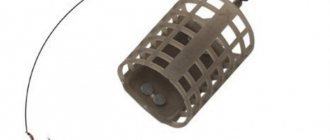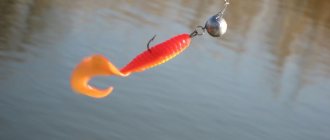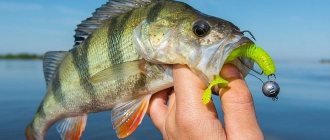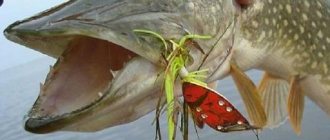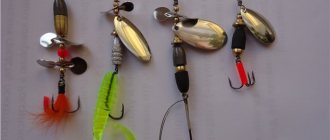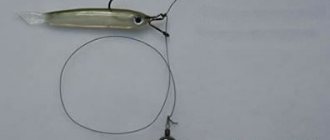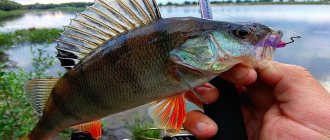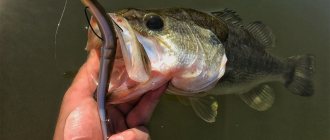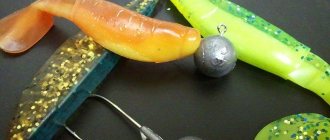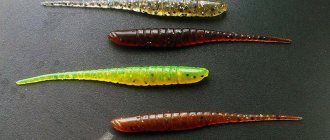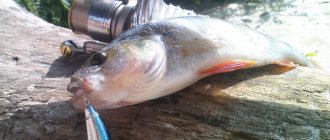No-hook jigs
The fish often stands in thick grass or snags where you can quickly run out of the entire day's supply of bait. In such cases, non-clinging options come to the rescue. But it should be said right away that this concept is rather arbitrary. Even such baits still sometimes get caught, get stuck in snags, between stones and break off. But this happens several times less often.
It is absolutely clear that any hook guards worsen hooking and the number of fish escapes increases significantly. Nevertheless, in many cases, “non-hooking” helps out.
How to choose the weight of the load during fishing
Often, beginning spinning anglers pay a lot of attention to equipment, choosing between a jig head or a Cheburashka.
Important! Don’t forget about one of the main factors that determines success in jig fishing. In fact, the bait will only be of interest to the predator if it behaves realistically under water.
This is achieved by precise selection of cargo. The problem is that it is necessary to find a balance between the mass of the equipment and its volume. Two points should be highlighted here.
- Active soft baits can only work well in combination with weights of a specific weight range. If the weight of the load goes beyond the upper or lower limit of this limit, malfunctions are observed in the bait’s performance, and the cunning fish does not attack it. In this regard, it is easier to work with foam rubber or polyurethane fish.
- For each predator, it is necessary to select a suitable falling speed for the bait on a particular day. For example, pike prefers long planning of the bait; the attack occurs at the end of a long pause (5-10 s). For pike perch, a rapid fall is required (2-5 s); the fish are probably stimulated by frequent tapping of the weight on the bottom. Therefore, at the same fishing point, you can use the weight of the load to selectively approach fishing.
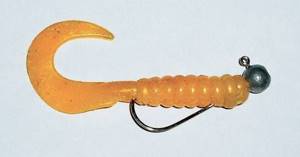
Photo 3. Large bait on a small head - for a standing pond.
There is a certain relationship between the weight of the cargo and the depth of the fished area. It is easiest to observe in still water.
- At a water depth of up to 2 m, a load weighing 2...8 g is suitable. In the shallows, sometimes baits with floating jig heads work better.
- To fish for a predator in lakes with a depth of 2-4 meters, a load weighing 5...12 g is required.
- In pits with a depth of 6 m, heavy heads weighing from 12 to 30 g are placed.
River fishing is even more difficult. Here it is necessary to take into account the strength of the current.
Recommendation! To reduce the influence of the current on the speed at which the bait falls, it is necessary to reduce the volume of the bait, while increasing the weight of the equipment. Compact baits equipped with tungsten jig heads come to the rescue.
Non-snagging jig heads with safety lock
The best and most versatile option is a jig head with a snag-proof hook (Fig. 1). The fuse can be a wire or plastic mustache, a bundle of fiberglass, or a rubber ring.
Fig.1. Non-hooking jig heads: a) with a wire loop; b) with a plastic mustache; c) with a bundle of fibers; d) with a rubber ring.
Other models of jig heads are designed so that the hook is partially hidden in the body of the bait, and only the very tip of the sting sticks out. When the fish grabs and hooks, the bait should slide down and “release” the hook (Fig. 2).
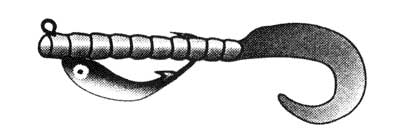
Fig.2. Jig head “Slo-Poke”.
Silicone in snags. The best non-snag
Date: January 25, 2021 | 510
When fishing with a spinning rod in general, and when fishing with soft silicone baits in particular, the angler very often encounters snags, hooks on the bottom and in the water column. On the one hand, the angler is annoyed by snagging and losing bait on snags. On the other hand, he himself often looks for such rubble or individual snags, because... near them there is often a concentration of fish and many bites occur. You have to find a balance between the desire to catch a predator and the risk of getting caught. In this article I want to talk about the use of various installations of silicone baits in snag conditions. Determine the best non-snags , installations that best pass through rubble and avoid snags.
Snags can be very different in their essence, composition, and geometry. The presence of a current in this place greatly affects the danger of snags.
It happens that a snag is just a separate flooded tree , and only its trunk part (the branches were broken off by time, they rotted, or they were carried away along with the broken off top).
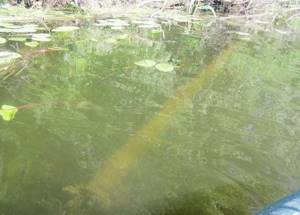
Such an obstacle at the bottom is very common. Predatory fish, pike, pike perch, large perch, love to stand behind such a log, under it.
Finding individual sunken trees like these and jigging them is a good way to get bites and catches.
Such a simple snag in its essence, however, not every jig installation will go through without getting caught.
So, the anti-champion, the worst installation in terms of non-clinging, should be recognized as a hinged installation based on a double or triple hook.
Only if such equipment passes exactly over the tree, there will be no snag. If contact happens, the probability of a hook, in my opinion, is at least 70-80%.
The hinged mounting with a single open hook has a slightly better non-clinging indicator. Simply due to fewer hooks...
Even a regular jig head passes through such places better. Although, she sits down very often. And for now we are considering the simplest type of snag...

Jig heads of different shapes have different driftwood penetration. Some are better at overcoming obstacles - others are very bad at it. Sometimes a jig head in the shape of a boot or a fish head works well on snags.
Installing such snags with a jig head, on which wire or line protection against snags is installed, works somewhat better. Such tricks work with individual snags, but in the rubble, in dense snags, they are practically useless.
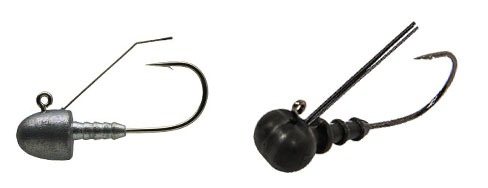
In practice, with close to 100% non-clinging properties, any installations on an offset hook can jump over such logs.
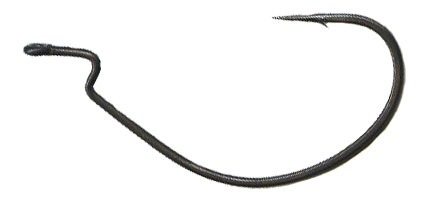
Now let's go through more complex snags and see how things are there.
A snag can be a whole tree or bush, with branches and root system.
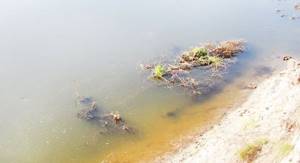
These can be entire rubble of sunken trees and individual branches. Such snags can be clearings, flooded at the bottom of reservoirs, or rubble caused by rivers. The formation of snags is always different. This makes them dangerous and interesting.

The snag can only be located at the very bottom, some fragments may be located in the thickness, or even come to the surface. Such multi-level thick snags are hell for a spinner. But, if you get creative, good trophies often await you there.
So, in dense snags, and even in the current, all the above-mentioned installations are simply no good. All that remains is to evaluate the offset hook and installations using it.
There is one interesting opportunity to catch snags by using spaced rigs, such as a diverting leash and a drop shot. The idea here is that the streamlined sinker will go along the bottom, and the bait with a hook will go higher. The main thing here is to know the snag well. And this will work if the driftwood, the blockage, is at the very bottom, without rising to the middle layers. If you guess the distance from the load to the place where the leash or drop-shot hook is attached, then you can fish the area without any hooks at all and lure out a predator stuck in the support. All that remains is the risk of getting the weight stuck among the branches. But this risk is much less than getting caught on a hook. And also, weights, especially homemade ones, are much cheaper than bait with a hook.
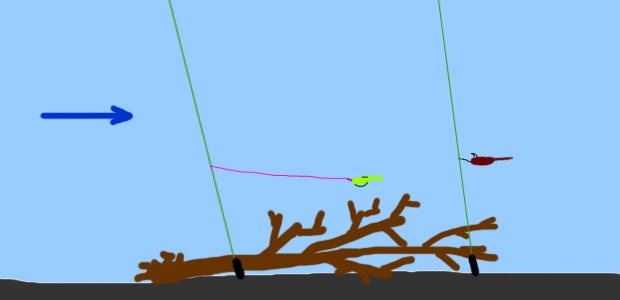
Such a spaced rig, like the Carolina one, is not very good in snags, because bait on a separate leash often gets caught in snags.
Not very thick snags can be easily overcome by hinged mounting based on an offset hook.
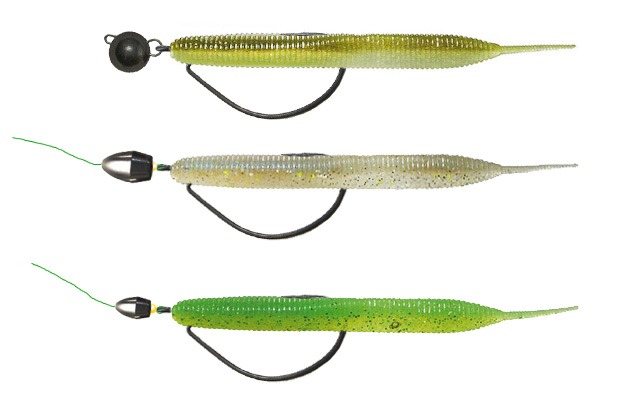
But, in thicker debris, the Cheburashka sinker very often gets jammed. And now we are coming to the moment to name the best setup for fishing among snags. The title of best hook-free bait in the section of fishing with silicone baits goes to Texas equipment.
The bullet-shaped weight, sliding along the leash, practically does not jam among the branches, and the offset hook most reliably avoids snags.
In order for the offset hook to fit better and hide in the body of the bait, it is desirable that it have a longitudinal groove, a cut on the back. Many models of modern edibles have it. So, there are no problems with this.
Naturally, in especially dense multi-tiered rubble and snags, even installations on offset hooks, even Texas, do not completely protect against snags. But, when compared with all other equipment, the loss of bait with this method is minimal.
Also, it should be noted that the lighter the bullet weight used for Texas installation, the better it passes obstacles at the bottom, snags. The same rule applies to all other installations. Lighter load means fewer snags.
So, we can summarize. , Texas equipment is best suited . For bold fishing of single snags and flooded tree trunks, you can use it, or at least a hinged rig with an offset hook. Depending on the situation, you can bypass the snags using a drop-shot or a lead leash. And all other installations with open hooks are normal solutions for more or less clean areas of the bottom.
Share with your friends:
Categories: Edible fishing Tags: Snags, Installation, Unhooked, Lures
Lightweight, snag-free hooks and rigs
There are also lightweight non-snagging rigs for the upper and middle layers of water (Fig. 3). They require special hooks - thicker and heavier, which are thrown further and do not tip over when retrieving. The twisters and narrow “fish” themselves should be soft, even better without torque – (“frog” or “cuttlefish”), because with an excessively hard twister and a light hook, the bait can “go into a tailspin.”
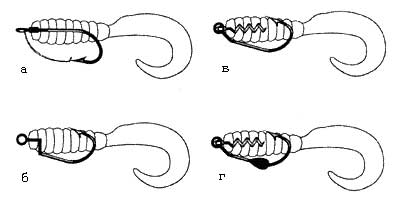
Fig.Z. Lightweight non-snagging rigs for top layers: a) non-snagging hook; b) “offset” hook; c) a hook with a corkscrew; d) loaded hook with a corkscrew.
For pike, a strong tungsten or braided leash is required. When cast horizontally, such top-mounted rigs give an even better effect than a “banjo-minnow,” because the hook here is hidden in the middle of the bait, where the predator most often “hits.”
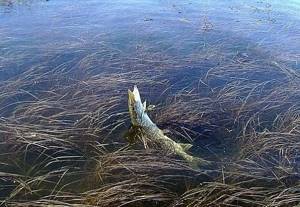
How to properly catch pike with unhooked hooks
For more successful use of bait, it is necessary to use different wiring techniques when fishing for pike. Let's look at the 5 most effective of them.
Effective postings
- The fish swims calmly.
The tackle moves at a constant speed, evenly. Such wiring alarms the predator; to him it seems to be cautious, healthy and hard-to-reach prey. Uniform wiring has proven itself well for pike fishing
Difference from the first posting: the fish and the predator are looking for food. The fish are careless in search of food and become easy prey. The predator immediately attacks such prey. Fish feed at different depths and places. Therefore, the bait must repeat its behavior.
Step wiring is used. The bait touches the bottom and raises turbidity, provoking a predator. It is more effective and catchy.
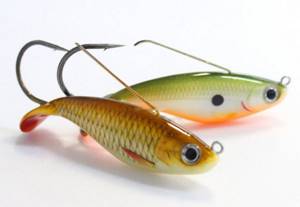
Spinner Rapala Weedless Shad
- Weak or sick fish.
The best prey for pike are sick fish. They move slowly and stop often. Fish tend to quickly go into cover and hide from danger. This option uses wiring that simulates the movement of a weak fish. The spinning rod is turned from side to side, smoothly accelerating and slowing down the movement of the tackle. The predator willingly rushes at such prey.
The fish moves sluggishly and erratically. It's very easy to eat. Wiring requires frequent stops and alternating movements. The pike reacts quickly and attacks quickly.
- The fish escapes from danger.
Danger awaits any inhabitant of a reservoir. Movements during flight are unpredictable. The fish hide in a cloud of turbidity at the bottom or jump to the surface. This can often be seen in shallow water. Retrieving is done in the same way: the bait is lowered to the bottom or raised to the very surface.
Removable non-snagging safety on the jig head
The option with a branch pushed the inventors to another version, when the protective element of transparent plastic is made separately and fits on any jig head of a suitable size (Fig. 5). This idea is the most practical: the fuse can be used with any bait, and can be easily removed if necessary. A few of these “shoots” are enough, and you don’t have to worry about snags. But while these “bells and whistles” are not available to us, we can only try to make something similar ourselves, for example, from tubes for droppers.
Fig.5. Removable plastic fuse: a) general view; b) mounting on a jig head.
In any case, you will definitely need some kind of “non-snag.” It often happens that a lazy pike stands among the thick grass, shows itself, plays, but you can’t get a regular bait through the grass, but it’s easy to get a “non-hooking” bait! Use this chance, and your catch will become more significant, and most importantly, you will learn to fish in more difficult non-standard conditions.

Video: Catching pike with unhooked hooks in the grass
Spinning fishing is at the peak of popularity today. Successful fishing requires good gear and skill. It is better for novice fishermen to study useful material on the desired topic in advance before going fishing, this will increase efficiency when fishing. Trained fishermen will benefit from knowledge and personal experience. And the use of non-hooking baits will allow you to catch pike in hard-to-reach places, increasing the chances of catching the desired trophy.
Unhooked or unhooked?
But some anglers, especially sportsmen, have a negative attitude towards non-hooking baits. Evgeniy Konstantinov calls them differently - “unhooked”. He believes that “if at a competition at least one fish leaves due to poor hooking (and the “largest” always leaves), then we need to get rid of the “unhooked” fish.”
As an athlete, I can understand Evgeniy, but as a fisherman, the further I go, the more I lean toward “non-snagging” (or better yet, “non-breaking”). The reason here is both economy and ecology.
“Unhooked” baits are the easiest way to conduct detailed reconnaissance of new places without fear of losing a lot of bait. And fish disappearances are not a reason to be very upset.
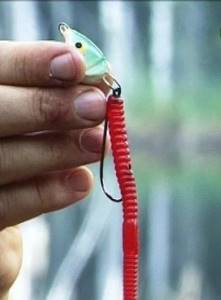
Another aspect is environmental: once, in a cluttered area, the three of us “left” fifty baits in a day - a kilogram of lead, foam rubber, plastic, hooks. Multiply this by the number of anglers and by “working days” - it turns out to be a lot! That’s why I’m against breaking baits, but on the other hand, I don’t want to lose fish either.
There is only one radical solution here - the use of strong fishing line and thin hooks that bend under extreme tension. As a last resort, you can slightly anneal by prying the hook - it will become softer, but do not anneal the tip.
What is fishing?

All over the world, almost the entire male population, to one degree or another, considers themselves fishermen. For some, fish is just food. All knowledge about ichthyofauna comes down to cooking and fishing for them is sporadic. For others, sitting with a fishing rod on the shore or long walks with a spinning rod, combing the coastline with a spoon, wobbler or jig bait, are considered the best active recreation, full of emotional sensations and communication with nature.
We will talk about the taste of fish in a separate section (fishing cookery), but now I would like to express my opinion about the term “recreational fishing”. How I imagine her.
I don’t like the interpretation that comes up when asked on Wikipedia:
Fishing is the activity of catching fish from a body of water for food or just for fun.
It’s somehow unpleasant to hear such a dry saying about such a favorite pastime.
Fishing is, first of all, an opportunity to get away from dusty and stuffy cities, enjoy clean air, have peace of mind, and a great mood. Feel the excitement of waiting for a bite and enjoy the joy of catching even a small fish. And if you are lucky and the fishing luck does not pass you by, then the surge of adrenaline from fighting a strong opponent will definitely be beneficial.
I don’t know who, history is silent, but certainly a wise and good person said: “Time spent fishing does not count towards life.” That's exactly what I noticed.
So we rush, as soon as possible, to the nearest lake, river, reservoir or small pond, at any time of the year or day, in order to push back old age, at least a little, and taste freedom. Because when fishing, no one owes or is obligated to anyone. Freedom!
And if someone calls you quietly crazy, so be it. Let's just sympathize with them. Such people are not given the opportunity to understand and experience the real feeling of buzz when a caught fish, regardless of size and type, is released into its native element. When blood-sucking mosquitoes and midges stubbornly crawl into your eyes and ears, and all your attention is focused on a slightly trembling float or the tip of a spinning rod.
Of course, we spend, and sometimes spend a lot, on gear and equipment. But is it worth remembering?
However, I got emotional and went off topic.
Fishing technique and tactics
- Before you go to a pond with such devices, you first need to decide on the fishing location. The main thing is to maintain silence, the pike is very shy and careful. A good catch of predatory fish is quite possible using different fishing rods, which you can play with to interest the fish when fishing with these spoons. The main thing is to apply them correctly, taking into account all the nuances.
- Some non-hooking hooks are good for use in snags and ponds overgrown with dense vegetation. Twisters and live baits are suitable.
- Having arrived at the fishing spot, you should pay attention to the bait. Artificial fish, wobblers, spoons or non-hooking baits in the root are suitable.
- To avoid fish getting off, it is better to use foam rubber for silicone offset hooks. In snags, do the wiring carefully, pulling the rod slowly and without jerking.
- Even if the bait gets stuck between snags, the spinning rod must be slowly pulled towards you until it comes out of the hook. It is better to throw the bait once again when fishing in water lilies, in the spaces between the leaves.
- To prevent unhooked baits from clinging to vegetation, it is better to fish with wiring in places where there is still no dense layer.
- Usually the predator grabs the bait immediately when the spoon falls into the water, but it is advisable to play with it. Pike loves it.
- If there are no bites, then it is better to reel in the line and try to cast the tackle again.
Do-it-yourself non-hooking
Non-clinging spinners can be made at home by adapting a classic spinner for this purpose.
Important! To produce the product, you only need a soldering iron and pliers. Additional accessories include a powerful single hook with an extended fore-end and a thick guitar string.
The treble hook and the winding ring for attaching it are removed from the factory spinner. A single hook is soldered into the body of the spinner from its concave part, with the calculation of the projection of the forend with the sting beyond the edge of the body of the product being 1.5 - 2 centimeters. Then cut a piece of string to a size 1/3 larger than the spoon itself with the hook soldered to it. A piece of string is soldered in the front part of the spinner body on the same hook mounting line. After soldering, the string is bent so that it rests on top of the hook tip, creating one center line with it.
The rigidity of the string material allows it to maintain its given shape, and with light pressure it can slightly deform, releasing the sting. This principle helps to avoid snags on the wires with minor resistance, but with more active deformations - and this is mainly the bite of a predator - to release the tip of the hook. With the help of these simple modifications, the spoon significantly changes its purpose and becomes a full-fledged non-hooking spinner for pike.
By the way, if you are a fan of experiments, then
Rating of the best unhooked hooks for pike
- MEPPS CYCLOPS spinners are excellent for fishing from the shore; thanks to their weight of no more than 28 g, they are distinguished by good volatility and interesting vibrations. The pike bites willingly, and even with a quick reel in of the line it will not fall off the hook.
- DAM EFFZETT are good non-snagging baits in flight, but it is better to fish with them from a boat, fishing places in the islands. Cleared of vegetation, or near the edge of algae growing in the water.
- KUUSAMO RASANEN are suitable for pike trolling. Spoon baits have proven their effectiveness in catching fish in thickets; they do not flutter when casting. It is better to catch medium-sized predators with them.
- AKME LITTLE CLEO from American manufacturers, excellent for catching pike weighing 5-7 kg. When fishing, it is recommended to replace the tees with stronger ones, as the original ones are quite weak.
- ABU GARSIA TOBI are suitable for catching small and medium-sized pike. The baits are simply excellent, easy to use, but large individuals do not go for them.
- BLUE FOX ESOX from European manufacturers, excellent competitors to American models with stepped wiring. They fly smoothly and quickly, catching large fish both from a boat and with a spinning rod will not take long.
